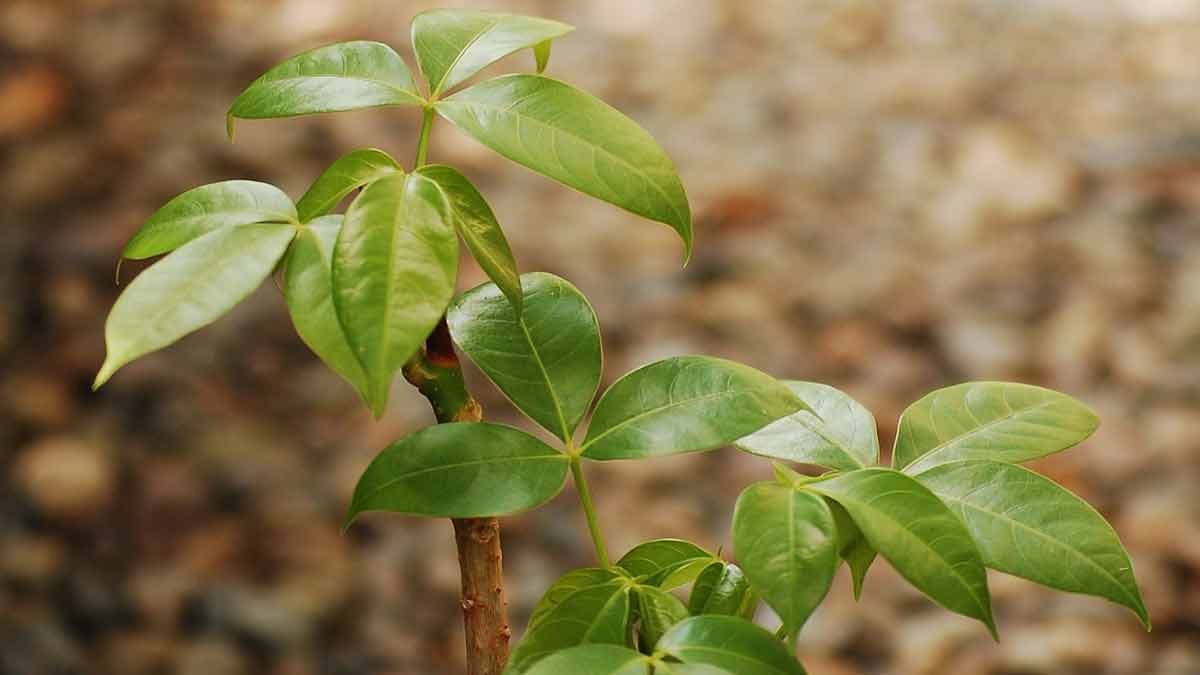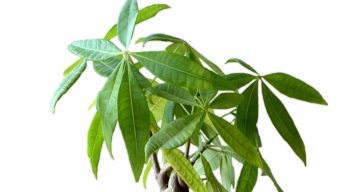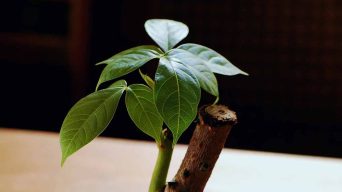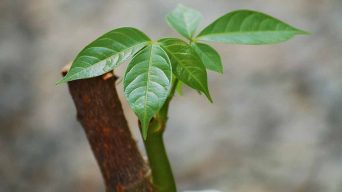Common signs of an underwatered Money Tree include dry soil, wilting leaves, and brown and crispy leaf edges. To prevent underwatering, water the plant when the top inch of soil has dried out and keep it in a location with bright indirect light and consistent humidity.
Money trees, often known as Pachira Aquatica or the Chinese Money Plant, have become popular among plant enthusiasts for their unique braided trunks and abundant symbolism of good luck and prosperity.
However, these beautiful houseplants can be fussy when watering, with underwatering causing damage that might leave your money tree in distress.
In this article, we’ll explore the critical signs of an underwatered money tree and provide solutions for reviving it back to health – ensuring you maintain a thriving indoor greenery beloved by many.
Signs Of Underwatering In A Money Tree
The signs of underwatering in a money tree can be easily identified by observing the plant’s physical characteristics.
When a money tree does not receive enough water, its leaves and stems wilt, and its leaf edges turn brown and crispy.
The soil around the plant becomes dry, and the plant’s growth becomes sluggish. Recognizing these signs is crucial for maintaining a healthy money tree.
Wilting Leaves And Stems
One telltale sign of an underwatered money tree is its leaves and stems wilting.
This occurs when the plant isn’t receiving enough moisture to sustain itself, resulting in a drooping or collapsing appearance as it struggles to maintain adequate hydration levels.
To address this issue, examine your watering habits and ensure you provide sufficient water to your money tree plant.
Typically, these plants should be watered thoroughly every 1-2 weeks, less frequently during cooler months when evaporation rates tend to decrease.
By improving your watering practices accordingly, you can prevent further wilted leaves and help restore vitality to your struggling Money Tree.
Brown And Crispy Leaf Edges
One of the most telling signs that your money tree is underwatered is the appearance of brown and crispy leaf edges.
This occurs when the plant doesn’t receive enough moisture to sustain its beautiful, vibrant foliage.
As a result, the leaves cells start to break down, causing them to lose their color and natural suppleness.
To help your struggling money tree regain its health, try gently increasing its water intake while monitoring other environmental factors such as sunlight and humidity levels.
For example, ensure it receives bright indirect light without exposure to direct sun for long periods, which can cause further damage from the scorching heat.
Dry Soil
One telltale sign of an underwatered money tree is persistently dry soil.
To adequately provide for your plant’s needs, it is crucial to maintain a balance between keeping the soil moist without causing excess water accumulation that could lead to root rot.
To check if your money tree suffers from underwatering, gently press a finger about an inch into the potting mix; if it feels dry or crumbly, it may indicate insufficient hydration.
In cases of prolonged underwatering with no intervention, severe damage can occur in the form of wilting leaves, crispy leaf edges, and slow growth rates.
Slow Growth
If you’ve noticed that your money tree is growing at a snail’s pace, it could be a sign of underwatering.
When a plant is not receiving enough water, it will conserve energy and reduce its growth rate to compensate for the lack of hydration.
However, before watering your money tree more often, check the soil moisture level first.
To address slow growth due to underwatering, gradually increase your watering frequency until you find the right balance.
Stick your finger into the soil about an inch deep—if it feels dry, it’s time to water.
Aim to keep the soil evenly moist but not soggy or waterlogged.
You can also mist the leaves or place a tray of pebbles underneath the pot to boost humidity levels and encourage healthy growth.
Solutions For Saving An Underwatered Money Tree
If you have an underwatered money tree, don’t worry – there are solutions to revive it and promote healthy growth.
Correcting your watering technique, increasing humidity levels, repotting it into fresh soil, and fertilizing can all help save your plant.
By following these simple steps, you can bring your money tree back to life and ensure it thrives in the future.
Correct Watering Technique
A proper watering technique is vital to the health of a money tree.
The soil should be soaked thoroughly, and excess water should drain from the pot’s base.
It’s essential to avoid overwatering as it can lead to root rot and other issues that harm your plant.
Always check the moisture level in the soil before watering, then adjust accordingly.
To ensure proper drainage, provide drainage holes on the bottom of your pot so any excess water can escape.
If you notice that leaves are drooping, this is likely a sign of underwatering or improper drainage.
When watering your money tree (or any plants), it’s better to err on under rather than over-watering as excessively wet roots could very easily lead to root rot disease, which can rapidly cause irreversible damage leading to the death of the entire plant within just days!
Increasing Humidity Levels
One common problem with underwatered Money Tree plants is that they can suffer from low humidity levels, which can cause the leaves to dry out and become crispy.
To combat this, increasing the humidity around your plant is important.
A straightforward way of doing this is by misting the plant regularly – spray water onto its leaves once a day to create a humid micro-climate around it.
Alternatively, place a tray filled with pebbles and water underneath the pot or invest in a humidifier for more consistent results.
Repotting Into Fresh Soil
When saving an underwatered Pachira aquatica, repotting it into fresh soil can be a game-changer.
Doing so gives the plant fresh nutrients and gives its roots room to grow without being suffocated by dry or compacted soil.
First, choose a pot that is one size bigger than its current container and has drainage holes. Next, prepare the new pot with a fresh potting mix specifically designed for indoor plants.
If you notice rot or dead roots, prune them before placing the plant into its new home.
Water thoroughly and place your newly potted Money Tree in bright indirect light to help promote healthy growth.
Fertilizing
Fertilizing is an essential part of maintaining a healthy and thriving Money Tree.
A balanced fertilizer with equal nitrogen, phosphorus, and potassium can promote growth and keep the plant vibrant.
However, it’s important to avoid overfertilizing as this can lead to burnt or damaged roots.
One helpful tip for fertilizing your money tree is to dilute the fertilizer mix by half before application.
This ensures that you don’t introduce too many nutrients at once, which can damage or even kill your plant.
Alternatively, you could opt for slow-release pellets that gradually deliver nutrients over time so you don’t have to worry about under or over-fertilization issues.
Prevention Methods To Avoid Underwatering
It is important to follow specific prevention methods to prevent underwatering of your money tree.
This includes:
- Regularly checking the soil moisture.
- Creating a watering schedule based on the plant’s needs and environmental conditions.
- Monitoring for drainage issues.
- Adjusting your watering practices for different seasons.
By implementing these measures, you can ensure that your money tree remains healthy and vibrant all year round.
Regularly Checking Soil Moisture
Regularly checking the soil moisture is crucial in preventing underwatering of money trees.
Before watering your plant, use a moisture meter or stick your finger about an inch deep into the soil to check if it feels dry or moist.
If the soil feels wet, hold off on watering until it dries out.
Adjusting your watering schedule according to seasonal changes and environmental conditions is also essential.
During humid weather conditions, reduce watering frequency since plants lose less water through transpiration.
In contrast, you may need to increase watering intervals during hot or dry seasons since plants lose more moisture through leaves and stems.
Regularly checking for drainage issues can help prevent overwatering and ensure that excess water doesn’t accumulate in the potting mix, leading to root rot over time.
Following A Watering Schedule
To avoid underwatering or overwatering your money tree, it’s important to follow a watering schedule.
This involves consistently checking the soil moisture and determining when it’s time for another round of watering.
For example, during the hot summer months, your money tree may require more frequent watering due to increased evaporation from the soil.
A helpful tip is to use a moisture meter or stick to indicate when it’s time for another round of watering.
Monitoring For Drainage Issues
Monitoring the soil’s drainage is crucial to prevent underwatering your money tree.
When there is poor drainage, water can accumulate in the roots and lead to root rot.
To address this issue, make sure your pot has a proper drainage hole that allows excess water to escape.
Another way to keep track of soil moisture is by using a moisture meter or sticking your finger about an inch deep into the soil.
If it feels dry, it’s time to water your plant.
Adjusting Watering Practices For Different Seasons
Watering plants during different seasons require a nuanced approach.
During summer, the soil tends to dry out faster.
The evaporation rate is high due to increased temperature and humidity levels.
As such, your money tree may require more frequent watering during this period.
In addition to adjusting watering practices for seasonal changes in environmental factors, you can also factor in internal changes within the plant as it responds to changing seasons.
For instance, when entering dormancy or slowing down its growth in preparation for winter (a common occurrence with money trees), reducing water intake will help prevent root rot and other issues associated with overwatering.
Final Thoughts
In conclusion, underwatering your money tree can cause serious damage if not detected early.
Check for droopy leaves, brown tips, and dry soil to prevent these issues.
Remember to water your plant correctly and increase humidity levels if you notice these signs.
For those who have overwatered their money trees, it’s vital to take immediate action by removing them from the container and replanting it in fresh soil.
As with all houseplants, preventative measures like checking soil moisture regularly are crucial in keeping them healthy and thriving.







